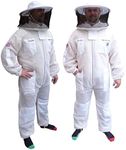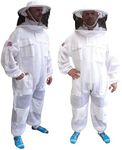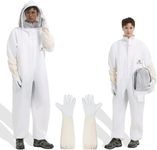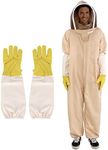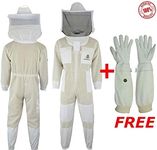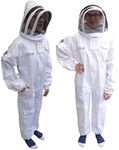Buying Guide for the Best Sting Proof Bee Suits
Choosing the right sting-proof bee suit is crucial for beekeepers to ensure safety and comfort while working with bees. A good bee suit will protect you from stings, allow for ease of movement, and provide ventilation to keep you cool. When selecting a bee suit, consider the following key specifications to find the best fit for your needs.MaterialThe material of a bee suit is important because it determines the level of protection and comfort. Common materials include cotton, polyester, and a blend of both. Cotton is breathable and comfortable but may not be as durable as polyester. Polyester is more durable and can offer better protection but may be less breathable. A blend of cotton and polyester can provide a balance of comfort and durability. Choose a material based on your need for protection versus comfort and the climate in which you will be working.
VentilationVentilation is crucial in a bee suit to prevent overheating, especially during hot weather. Some suits come with built-in ventilation panels made of mesh or other breathable fabrics. These panels are usually located in areas where heat tends to build up, such as the back and underarms. If you work in a hot climate or tend to overheat easily, look for a suit with good ventilation to keep you cool and comfortable.
Fit and SizeThe fit and size of a bee suit are important for both protection and comfort. A suit that is too tight may restrict movement and increase the risk of stings, while a suit that is too loose may allow bees to get inside. Bee suits typically come in various sizes, so it's important to choose one that fits well. Consider trying on different sizes or consulting size charts to find the best fit for your body type. Ensure that the suit allows for a full range of motion and can be worn over your regular clothing.
Veil TypeThe veil is a critical part of a bee suit as it protects your face and neck from stings. There are different types of veils, including round veils, fencing veils, and hooded veils. Round veils offer good visibility and ventilation but may be bulkier. Fencing veils are more streamlined and provide a good balance of visibility and protection. Hooded veils offer full coverage and are easy to put on and take off. Choose a veil type based on your preference for visibility, ease of use, and the level of protection you need.
Closure SystemThe closure system of a bee suit ensures that there are no gaps through which bees can enter. Common closure systems include zippers, Velcro, and elastic bands. Zippers provide a secure and tight seal but may be less flexible. Velcro is easy to use and adjust but may wear out over time. Elastic bands offer flexibility and can be used in conjunction with zippers or Velcro for added security. Consider the ease of use and durability of the closure system when choosing a bee suit.
Pockets and StoragePockets and storage options in a bee suit can be very useful for carrying tools and other essentials while working with bees. Some suits come with multiple pockets, including large pockets for tools and smaller pockets for items like your phone or keys. Consider how many pockets you need and their placement on the suit. Ensure that the pockets are easily accessible and have secure closures to prevent items from falling out.




